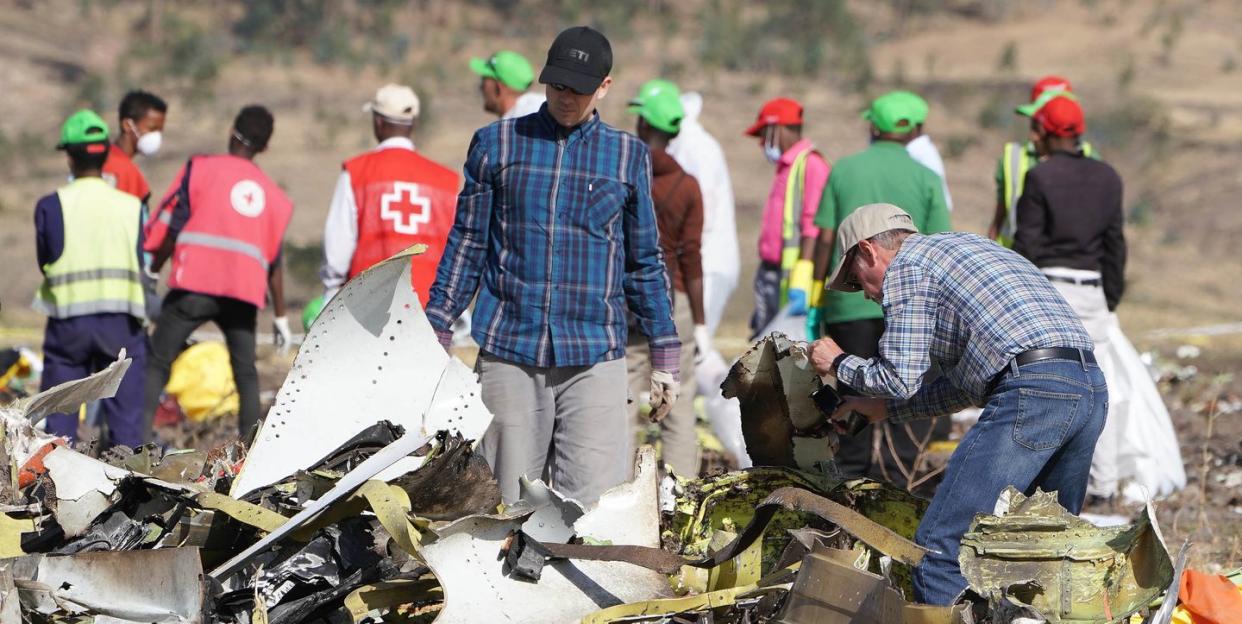Ethiopian Airlines Pilot Reported Flight Control Problems Just Before Catastrophic Crash

The pilot of the doomed Ethiopian Airlines flight that crashed on Sunday reported flight-control problems shortly after takeoff, representatives from the airline told Reuters.
Sunday's disaster, in which 150 passengers were killed, was the second fatal incident involving the Boeing aircraft model in five months: Last November, Lion Air Flight 610 crashed into the Java Sea minutes after takeoff, killing 189 people. The black box data recorder devices from Ethiopian Airlines Flight 302 are now being sent to investigators in Europe, who will probe what ultimately caused the disaster.
A spokesperson for Ethiopian Airlines told Reuters that the pilot quickly requested to return to Bole Airport in Addis Ababa mere minutes after leaving the tarmac. The flight encountered no external problems, such the plane colliding with birds, according to the spokesperson. The pilot was granted permission to return to the airport, but crashed in the desert just six minutes after takeoff.
The question now facing investigators and the broader aviation industry, is whether the two incidents were linked by a common, fatal flaw. In the case of Lion Air, a preliminary report indicated that a faulty software issue prompted the plane to lower its nose. Pilots tried to override the glitch by tilting the plane's nose upward, but were ultimately unsuccessful.
Pilots for at least two different airlines had previously raised concerns about the automatic nose-down safety feature, with one pilots calling Boeing's Max 8 safety manual “inadequate and almost criminally insufficient,” according to reports.
"External reports are drawing similarities between (the Ethiopian) accident and the Lion Air Flight 610 accident," the FAA said in a statement Tuesday. "However, this investigation has just begun and to date we have not been provided data to draw any conclusions or take any actions."
The Ethiopian Airlines incident has prompted a mass grounding of Boeing's Max 8 jets throughout the world, with Great Britain, China and various other countries ordering the aircraft grounded pending further oversight. So far, authorities in the United States and Canada have allowed the jet to remain in operation, despite the 22 airlines globally that have grounded their fleets. Roughly two-thirds of Max 8 aircraft around the world have been taken out of service, according to the New York Times.
The Federal Aviation Administration on Tuesday issued a statement, assuring that the Max 8 jets in U.S. airspace meet the safety standards needed to fly.
The agency's acting administrator, Daniel K. Elwell, said:
The FAA continues to review extensively all available data and aggregate safety performance from operators and pilots of the Boeing 737 MAX. Thus far, our review shows no systemic performance issues and provides no basis to order grounding the aircraft. Nor have other civil aviation authorities provided data to us that would warrant action. In the course of our urgent review of data on the Ethiopian Airlines Flight 302 crash, if any issues affecting the continued airworthiness of the aircraft are identified, the FAA will take immediate and appropriate action.
Despite calls from politicians across the spectrum to issue a universal grounding order, the FAA has allowed the planes to traverse U.S. airspace. On Tuesday, President Trump spoke with Boeing CEO Dennis Muilenberg over the phone, after tweeting that modern planes "are becoming far too complex to fly."
The scrutiny placed on the Max 8 has proven devastating for U.S. manufacturing giant Boeing, which saw its stock valuation tumble by $29 billion amid the worldwide grounding of one of its most popular planes. On Tuesday, the FAA ordered Boeing to update the software on its Max 8 fleet, in an effort to update automated its safety protocol.
('You Might Also Like',)

